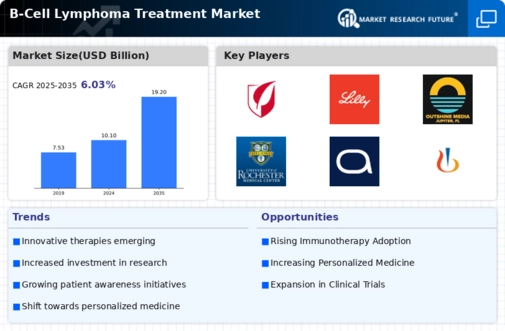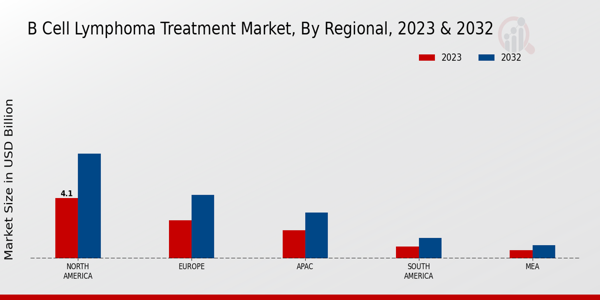Advancements in Precision Medicine
Advancements in precision medicine are significantly influencing the B-Cell Lymphoma Treatment Market. The integration of genomic profiling and biomarker identification into treatment protocols allows for more tailored therapeutic approaches. This shift towards personalized medicine enhances treatment efficacy and minimizes adverse effects, which is particularly crucial for B-Cell lymphoma patients. Recent data suggests that targeted therapies, which are a cornerstone of precision medicine, have shown improved response rates in clinical trials, leading to a growing preference among oncologists. As healthcare providers increasingly adopt these innovative strategies, the B-Cell Lymphoma Treatment Market is likely to witness substantial growth. The focus on individualized treatment plans not only improves patient outcomes but also drives pharmaceutical companies to invest in research and development, further propelling the market forward.
Rising Investment in Cancer Research
The rising investment in cancer research is a pivotal driver for the B-Cell Lymphoma Treatment Market. Governments and private organizations are allocating substantial funds to enhance research initiatives aimed at understanding the complexities of B-Cell lymphoma. This influx of capital facilitates the exploration of novel treatment options, including new drug development and clinical trials. For instance, recent funding reports indicate that cancer research funding has increased by over 15% in the past few years, underscoring the commitment to combating this disease. As a result, the B-Cell Lymphoma Treatment Market is poised for growth, as innovative therapies emerge from these research endeavors. The collaboration between academic institutions and pharmaceutical companies further accelerates the pace of discovery, ensuring that patients have access to cutting-edge treatments.
Emergence of Novel Therapeutic Agents
The emergence of novel therapeutic agents is reshaping the B-Cell Lymphoma Treatment Market. Recent advancements in drug development have led to the introduction of innovative therapies, including CAR T-cell therapy and bispecific antibodies, which have demonstrated remarkable efficacy in treating B-Cell lymphoma. Clinical trials have shown that these new agents can lead to higher response rates and improved patient outcomes compared to traditional therapies. As these novel treatments gain regulatory approval and enter the market, they are expected to significantly impact the treatment landscape for B-Cell lymphoma. The increasing availability of these advanced therapies is likely to drive competition among pharmaceutical companies, further enhancing the B-Cell Lymphoma Treatment Market. This dynamic environment fosters continuous innovation, ultimately benefiting patients with more effective treatment options.
Growing Awareness and Early Diagnosis
Growing awareness and early diagnosis of B-Cell lymphoma are crucial factors driving the B-Cell Lymphoma Treatment Market. Increased public awareness campaigns and educational initiatives have led to a greater understanding of lymphoma symptoms, encouraging individuals to seek medical attention sooner. This trend is reflected in the rising number of early-stage diagnoses, which can significantly improve treatment outcomes. Recent studies indicate that early intervention can enhance survival rates by up to 30%, emphasizing the importance of timely diagnosis. As healthcare providers focus on improving screening and diagnostic techniques, the B-Cell Lymphoma Treatment Market is likely to benefit from an influx of patients seeking treatment. This proactive approach not only aids in better patient management but also stimulates demand for innovative therapies tailored to early-stage B-Cell lymphoma.
Increasing Incidence of B-Cell Lymphoma
The rising incidence of B-Cell lymphoma is a critical driver for the B-Cell Lymphoma Treatment Market. Recent statistics indicate that the prevalence of this type of cancer has been steadily increasing, with an estimated 20,000 new cases diagnosed annually in certain regions. This surge in cases necessitates the development and availability of effective treatment options, thereby propelling market growth. As healthcare systems strive to address this growing burden, investments in research and development are likely to increase, fostering innovation in treatment modalities. Furthermore, the aging population, which is more susceptible to various forms of lymphoma, contributes to this upward trend. Consequently, the B-Cell Lymphoma Treatment Market is expected to expand as healthcare providers seek to implement advanced therapies to meet the rising demand.


















Leave a Comment